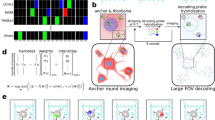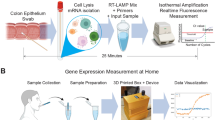Abstract
In this protocol we describe the in situ PCR method for the amplification of both DNA and mRNA targets [in situ reverse transcriptase-PCR (RT-PCR)], from frozen or paraffin-fixed tissue sections, cell culture or other single-cell suspensions. Detection of amplicons can be achieved by the hybridization and detection of labeled probes. The protocol includes the following steps: (i) tissue preparation, (ii) in situ PCR (or in situ RT-PCR), (iii) probe hybridization, (iv) signal detection. The technique has high sensitivity (geometrically PCR-amplifying 150–350 bp fragments of a gene of interest in situ) and specificity (derived from in situ hybridization with specific fluorescent or biotinylated probes for the target genes). The ability to identify individual cells, expressing or carrying specific genes of interest in a latent form in a tissue section under the microscope provides a visual account of silent genes, and allows the determination of various aspects of normal versus pathological conditions, or latent versus active viral replication. An average of 48 h is required to carry out the technique.
This is a preview of subscription content, access via your institution
Access options
Subscribe to this journal
Receive 12 print issues and online access
$259.00 per year
only $21.58 per issue
Buy this article
- Purchase on Springer Link
- Instant access to full article PDF
Prices may be subject to local taxes which are calculated during checkout





Similar content being viewed by others
References
Bagasra, O. Polymerase chain reaction in situ. Amplifications 4, 20–21 (1990) Editorial note.
Pestaner, J.P., Bibbo, M., Bobroski, L., Seshamma, T. & Bagasra, O. Potential of in situ polymerase chain reaction in diagnostic cytology. Acta Cytol. 38, 676–680 (1994).
Patterson, B. et al. Detection of HIV-I DNA and messenger RNA in individual cells by PCR-driven in situ hybridization and flow cytometry. Science 260, 976–979 (1993).
Maggioncalda, J., Mehta, A., Bagasra, O., Fraser, N.W. & Block, T.M. A herpes simplex virus mutant with a deletion immediately upstream of the LAT locus establishes latency and reactivates from latently infected mice with normal kinetics. J. Neurovirol. 2, 268–278 (1996).
Sullivan, D.E., Bobroski, L.E., Bagasra, O. & Finney, M. Self-seal reagent: evporation control for molecular histology procedure without chambers, clips or fingernail polish. BioTechniques 23, 320–225 (1997).
Winslow, B.J., Pomerantz, R.J., Bagasra, O. & Trono, D. HIV-1 latency due to the site of proviral integration. Virology 196, 849–854 (1993).
Bobroski, L. et al. Localization of human herpes virus type 8 (HHV-8) in the Kaposi's sarcoma tissues and the semen specimens of HIV-1 infected and uninfected individuals by utilizing in situ polymerase chain reaction. J. Reprod. Immunol. 41, 149–160 (1999).
Embretson, J. et al. Analysis of human immunodeficiency virus-infected tissues by amplification and in situ hybridization reveals latent and permissive infections at single-cell resolution. Proc. Natl. Acad. Sci. USA 90, 357–361 (1993).
Embretson, J. et al. Massive covert infection of helper T lymphocytes and macrophages by HIV during the incubation period of AIDS. Nature 362, 359–362 (1993).
Ewida, A.S., Raphael, S. & Bagasra, O. The presence of IL-2 and IL-10 cytokines in the skin lesions of Blau syndrome. Appl. Immunohistochem. Mol. Morphol. 10, 171–177 (2002).
Harrington, W.J. Jr. et al. Human herpes virus 8 (HHV-8) DNA sequences in cell-free plasma and mononuclear cells of Kaposi's sarcoma patients. J. Infect. Dis. 174, 1101–1105 (1996).
Nuovo, G.J. PCR. In Situ Hybridization Protocols and Applications 2nd edn. (Raven Press, New York, 1994).
Bagasra, O., Hauptman, S.P., Lischner, H.W., Sachs, M. & Pomerantz, R.J. Detection of human immunodeficiency virus type 1 provirus in mononuclear cells by in situ polymerase chain reaction. N. Engl. J. Med. 326, 1385–1391 (1992).
Bagasra, O., Seshamma, T. & Pomerantz, R.J. Polymerase chain reaction in situ: intracellular amplification and detection of HIV-1 proviral DNA and other specific genes. J. Immunol. Methods 158, 131–145 (1993).
Bagasra, O., Seshamma, T., Oakes, J. & Pomerantz, R.J. High percentages of CD4-positive lymphocytes harbor the HIV-1 provirus in the blood of certain infected individuals. AIDS 7, 1419–1425 (1993).
Bagasra, O. et al. Human immunodeficiency virus type 1 infection of sperm in vivo. AIDS 8, 1669–1674 (1994).
Bagasra, O. et al. Activation of the inducible form of nitric oxide synthetase in the brains of patients with multiple sclerosis. Proc. Natl. Acad. Sci. USA 92, 12041–12045 (1995).
Sirianni, M.C. et al. Human herpesvirus 8 DNA sequences in CD8+ T-cells (Let). J. Infect. Dis. 176, 541 (1997).
Bagasra, O. et al. In situ polymerase chain reaction and hybridization to detect low abundance nucleic acid targets. In Current Protocols in Molecular Biology (eds. Ausubel et al.) 1–49 (John Wiley & Sons, New York, 1995s).
Bagasra, O. et al. Cellular reservoirs of HIV-1 in the central nervous system of infected-individuals: identification by the combination of in situ polymerase chain reaction and immunohistochemistry. AIDS 10, 573–585 (1996).
Bagasra, O. & Amjad, M. Protection against retroviruses are owing to a different form of immunity. An RNA-based molecular immunity hypothesis. Appl. Immunohistochem. Mol. Morphol. 8, 133–146 (2000).
Bobroski, L. et al. Mechanism of vertical transmission of HIV-1: role of intervillous space. Appl. Immunohistochem. Mol. Morphol. 7, 271–279 (1999).
Pellett, P.E. et al. Multicenter comparison of PCR assays for detection of human herpesvirus 8 DNA in semen. J. Clin. Microbiol. 37, 1298–1301 (1999).
Qureshi, M.N. et al. Localization of HIV-1 proviral DNA in oral mucosal epithelial cells. J. Infect. Dis. 171, 190–193 (1994).
Strayer, D.S. et al. Titering replication-defective virus for use in gene transfer. BioTechniques 22, 447–451 (1997).
Pereira, R.F. et al. Cultured adherent cells from marrow can serve as long-lasting precursor cells for bone, cartilage, and lung in irradiated mice. Proc. Natl. Acad. Sci. USA 92, 4857–4861 (1995).
Hooper, D.C. et al. Prevention of experimental allergic encephalomyelitis by targeting nitric oxide and peroxynitrite: implications for the treatment of multiple sclerosis. Proc. Natl. Acad. Sci. USA 94, 2528–2533 (1997).
Lattime, E.C. et al. Expression of cytokine mRNA in human melanoma tissue. Cancer Immunol. Immunother. 41, 151–156 (1995).
Franklin, R.B. et al. hZIP1 zinc uptake transporter down regulation and zinc depletion in prostate cancer. Mol. Cancer 4, 32 (2005).
Rishi, I.R. et al. Down-regulation of hZIP1 and hZIP2 zinc transporters in the prostate cancer tissues from African decent as compared to Caucasian men. Appl. Immunohistochem. Mol. Morphol. 10, 171–177 (2003).
Bagasra, O. & Hansen, J. In situ PCR Techniques (John Wiley & Sons, New York, 1997).
Bagasra, O. et al. Localization of human herpes virus type 8 in human semen by in situ PCR. J. Mol. Histol. 36, 401–412 (2006).
Tani, K., Kurokawa, K. & Nasu, M. Development of a direct in situ PCR method for detection of specific bacteria in natural environments. Appl. Environ. Microbiol. 64, 1536–1540 (1998).
Maruyama, F. et al. Detection of bacteria carrying the stx2 gene by in situ loop-mediated isothermal amplification. Appl. Environ. Microbiol. 69, 5023–5028 (2003).
Roberts, C.H., Madrigal, J.A. & Marsh, S.G. Cloning and sequencing alleles of the KIR2DL4 gene from genomic DNA samples. Tissue Antigens 69 (Suppl. 1): 88–91 (2007).
FitzGerald, O.M., Hess, E.V., Chance, A. & Highsmith, R.F. Quantitative studies of human monokine-induced endothelial cell elongation. J. Leukoc. Biol. 41, 421–428 (1987).
Acknowledgements
The author is very grateful for the technical assistant of Drs. Ariana Stir and Samina Noorali. I am also very grateful for the artwork of Muhammad Hussain and logistic assistant of Sajid Saleem.
Author information
Authors and Affiliations
Corresponding author
Rights and permissions
About this article
Cite this article
Bagasra, O. Protocols for the in situ PCR-amplification and detection of mRNA and DNA sequences. Nat Protoc 2, 2782–2795 (2007). https://doi.org/10.1038/nprot.2007.395
Published:
Issue Date:
DOI: https://doi.org/10.1038/nprot.2007.395
This article is cited by
-
Potential role of M2 TAMs around lymphatic vessels during lymphatic invasion in papillary thyroid carcinoma
Scientific Reports (2021)
-
Detecting the colonization of ericoid mycorrhizal fungi in Vaccinium uliginosum using in situ polymerase chain reaction and green fluorescent protein
Plant Methods (2020)
-
Identification of Insulin Receptor Splice Variant B in Neurons by in situ Detection in Human Brain Samples
Scientific Reports (2018)
-
Pixelated spatial gene expression analysis from tissue
Nature Communications (2018)
-
Robust RNA-based in situ mutation detection delineates colorectal cancer subclonal evolution
Nature Communications (2017)
Comments
By submitting a comment you agree to abide by our Terms and Community Guidelines. If you find something abusive or that does not comply with our terms or guidelines please flag it as inappropriate.



